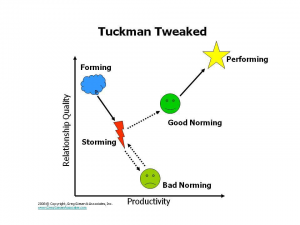At the University of Denver, Greg Giesen and Lauri Osborne developed a model called Tuckman Tweaked: A Revised Model of Group Development.
As you know, the forming–storming–norming–performing model of group development was first proposed by Bruce Tuckman in 1965, who stated that these phases are all necessary and inevitable in order for the team to grow, to face up to challenges, to tackle problems, to find solutions, to plan work, and to deliver results

We really love this Tuckman Tweaked model – and who wouldn’t, it has a smiley face in it!
What is also exciting about the model is that it recognises the behaviours essential for, and detrimental to, team success and highlights that without good leadership group development is not a set of stages leading to high performance.
Simply putting a group of technically proficient people, together, regardless of their IQ scores, does not make a successful team. We all know that. Success has less to do with who is in a team, and more with how a team’s members interact with one another. It is the relationships between team members that affect everyone’s productivity and happiness.
Daniel Goleman wrote in Emotional Intelligence that three conditions are essential to group effectiveness: trust among members, a sense of group identity and a sense of group efficacy. In teamwork, emotional intelligence is the essential social lubricant providing the capacity to settle disputes well, brainstorm creatively and work harmoniously. Our recent blog discussed Google’s data-driven research that found that the best teams respect one another’s emotions and are mindful that all members should contribute to the conversation equally.
OK, what does that look like?
All this is great information if you are studying leadership or writing a blog, but how do you translate that into action every day in the workplace? Maybe you could time everyone with the talking stick to make sure speaking slots are evenly shared…..but what about respecting emotions? What does that look like? Is it about acknowledging the emotion or empathising? Then there is trust – everybody knows you need it, but how do you create it?
This is where the model and accompanying paper excels. By ‘tweaking’ Tuckman’s stages to enhance its relevance to groups, teams, and their leaders Giesen and Osborne divided norming into two separate stages: good norming and bad norming.
During the Norming stage the team establishes ‘Norms’ , these are the attitudes and behaviours, that eventually become the habits, that ultimately decide the groups success.
The Good Norming Stage
A team can get to good norming by way of storming; more specifically, by effectively addressing issues and working through conflicts, and emerge as a more synergistic team as a result of their success. Once in good norming, the team quickly gains its balance and enters this tranquil phase as everything begins to settle into place. Team members find standard ways to do routine things, they drop the power plays and grandstanding, and everyone makes a conscious effort to work together. The newly formed norms are constructive in nature and foster teamwork and open communication.
Behaviours associated with Good Norming:
-
Each person on the team speaks approximately equally
-
Team members have good intuition for sensing how others are feeling based on their tone of voice and body language.
-
Members were confident they won’t be judged if they make suggestions.
-
Members felt they could take risks because other team members cared about them.
-
Members anticipate problems and address them before they happen
-
Members focus on what the team can control
-
Members focus on problem solving not blaming
-
Members make time to discuss difficult issues and the emotions around them
The Bad Norming Stage
Teams that are unable to address or work through critical issues, conflict, or relationship dynamics, move into bad norming. In bad norming, interpersonal relationships become strained, dysfunctional norms evolve, subgroups and self-protective behaviours emerge, and the team leader’s ability to lead continues to decline. In truth, it is the team leader who is primarily responsible for the team even being in the bad norming stage and it is not unusual to see a widening gap develop between the team leader and his/her team in this stage.
Example behaviours of a team stuck in the Bad Norming Stage
-
Team member talks about another team member instead of to that team member
-
Team leader refuses to handle a problem within the team and tells the complaining team member to mind his/her own business
-
Team is made up of two or three cliques who refuse to cooperate with one-another except on a very minimal level
-
Team members are so apprehensive about bringing up an issue that they’d rather avoid it or sweep it under the rug
What teams need in the Bad Norming Stage
Team members in the bad norming stage need to know:
-
The problems within their team are either being addressed or will be addressed
-
The team leader is accountable for his/her share of the situation
-
The organization is aware of the problem and committed to resolving it
-
The status quo is viewed as unacceptable by team members
-
Team and team leader are willing to do whatever it takes to turn the situation around
When teams enter the bad norming stage, one of two things usually happens: 1) The team stays stuck in that stage and eventually have to be replaced, dissolved or at least dismantled in part; or 2) They fix whatever needs to be fixed by going back to storming and then hopefully on to good norming.
As the model shows, a team in bad norming cannot simply move to good norming without first going back through the storming stage. This means that the team needs to be prepared to address, correct, and resolve the very issues that caused them to move into bad norming in the first place.
Outside intervention at this point can be useful, bringing an unbiased specialist in to facilitate the group development and assist the team work back through storming, giving them the tools they need to move to a better place.
What could prevent a team from moving out of Bad Norming
-
Continued fear of conflict
-
Team members unwilling to go back to the storming stage to revisit unresolved issues
-
Teams who have gotten used to the dysfunction
-
Distrust in the team leader’s ability to lead
-
Team’s dysfunction has become too entrenched
-
Team truly needs to have a member terminated but whose organization refuses to pull the trigger
-
Team that is still able to meet their productivity goals, in spite of themselves
-
Team leader denies any problem exists
-
Organisation refuses to intervene
Take a moment to consider:
-
What stage of development is your current team (or work group) in?
-
Does your team have the potential to be a high performing team? If so, what might be getting in the way?
-
Do you have a team stuck in bad norming?
Need more? We can get you started by facilitating a Behavioural Standards Workshop for you and your team. This workshop is about creating behavioural standards that give guidance for both the staff members who are responsible for the behaviours, and also for the Team Leaders who are responsible for managing the performance of the staff. Contact us to find out more.
Reference: Read the full paper on Tuckman Tweaked
We hope you enjoyed our blog?
Please subscribe to our mailing list to get more great ideas and updates fortnightly. In return we will send you our free ebook ' The Essential Guide to Exceptional Communication'.




